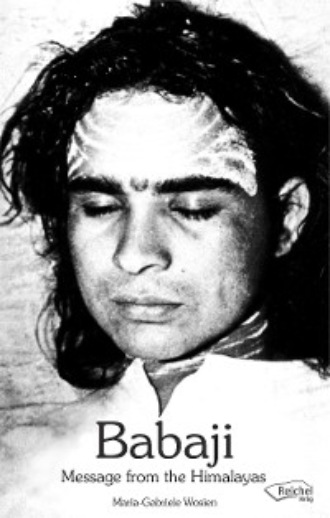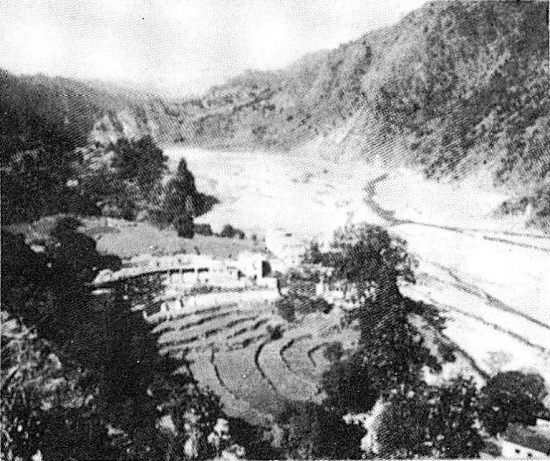
Полная версия
Babaji - Message from the Himalayas

The book
Now, as at all crucial turning points in history, when this planet and all its living forms faces total destruction, help arrives from higher sources of consciousness. Many great beings incarnate into human form to show humankind, at present lost and bewildered, the way out of the threatening chaos.
Babaji reappeared in 1970 at the foot of Mount Kailash in the Himalayas - the area worshipped since time immemorial as the axis of the earth and dwelling place of the gods.
In his book, Autobiography of a Yogi, Yogananda refers to Babaji as Mahaavatar, the great immortal Being, embodiment of the highest consciousness, the one who has forever acted as spiritual guide for human beings and who appears more publicly at critical moments in history, when only the direct intervention of the divine can alter its course.
Like Christ two thousand years ago, Babaji came recently in a human body and lived among the people 1970 - 84), teaching them by example the timeless message of the universal divine laws, based on truth, simplicity and love.
According to Babaji's prophecies our planet is undergoing a total transformation to the point of the collapse of our civilizations and the decimation of the human race through a series of cataclysmic events. Following this a new age of peace would begin. Babaji taught that the way to live happily and successfully and not waste the opportunity of this lifetime was to be continuously mindful of the divine, to surrender the fruits of one's actions to the divine and to work in service to humanity and to creation as a whole. He taught that this was the relevant and true yoga of the times.
He recommended the repetition of the mantra Om namaha Shivaya, which means "I take refuge in God" or "Thy will be done, O Lord".This mantra has the power to awaken the innate potential present in each human being to come to know his/her true divine nature, of which Babaji is the pure example.
The author
Dr. Maria-Gabriele Wosien studied Slavic Studies at the Universities of London and St. Petersburg, with a doctorate on the Russian fairy tale. She studied Western and Eastern sacred traditions and developed numerous dance choreographies. Her particular interest is the religious-ritual origin of the dancefolklore. Her work is focused on the conscious experience of mythical images and symbols that can unfold their healing power. Her dance productions are based on traditionally handed out movementarchetypes, based on sacred, classical and folklore music.

Maria-Gabriele Wosien
Babaji
Message from the Himalayas

Table of Content
Cover
The book / The author
Title
Table of Content
I SADASHIVA AVATAR
1) Encounter
2) About Hindu Philosophy
3) The Avatar as divine incarnation
4) The Avatar in Shaivism
5) Haidakhan Vishwamahadham - centre of the mythology around Babaji as Shivaavatar
6) Haidakhan Baba - historical review
II BABAJI'S LILAS
1) Experiences of devotees: 1800-1922
2) Experiences: 1922-1970
3) Mahendra Baba
4) Experiences after 1970
III Sadhana (Spiritual Practice)
1) Puja (Ritual Worship) and Yagna (Sacrificial Fire)
2) Master and disciple. Sadhana
3) Babaji and the sanatana dharma
EPILOGUE
PHOTOS
GLOSSARY
NOTES
I SADASHIVA AVATAR
II BABAJI'S LILAS
III SADHANA [Spiritual Practice]
EPILOGUE
IMPRINT
The author wishes to express her gratitude to the ashram of Haidakhan Vishwamahadham for kindly making available the accounts of devotees' experiences, and to Swami Fakiranand and Dr V V S Rao for their help in collecting the material for this publication.
M. G. Wosien

I SADASHIVA AVATAR
1) ENCOUNTER
Bhole Baba ki jai! ..... Bhole Baba ki jai! ..... Bhole Baba ki jai! These shouts of joy can be heard from the direction of the river ..... becoming more and more distinct now. In a few minutes Babaji will come into view as the thick line of bushes along the dusty village track turns wispy and comes to an end. Every afternoon, after bathing in the river, he returns to the temple on the hill, always pursued by a motley group of people - a mixture of devotees, curious onlookers and a straggle of children.
It is about five o'clock. The intense heat of the day has passed and it feels good to be outside again, beyond the dormitory'; cool and shady shelter so eagerly sought a few hours ago. I feel refreshed after taking a bath in the pleasant late afternoon sunshine and relieved that it's over and done with, happy at the sight of the washing completed - metres and metres of colourful, dripping wet saris and other garments hanging out on a line strung between two trees near our room.
Accustomed to the mod cons of western urban life, I have been finding it difficult to adapt to the 'simple' ways of an Indian village. I hadn't even known such ways existed! For instance, I've only just figured out how to bathe in public while fully dressed - well practically anyhow. It's' far easier on a moonless night when we take the morning bath. The twice daily bathing ritual, before sunrise and at sunset, is a sacred duty for every religious Indian.
My attempt goes something like this: unravel the sari and let it fall to the ground; hitch up the half-petticoat to the underarms and secure it tightly; remove the sari blouse; if lucky enough to have found a rare bucket at this hour, lower it slowly, slowly into the deep well and take care to keep my balance. The well's familiar inhabitant, a giant tortoise, nimbly dodges the shakily descending bucket, and then there's the job of heaving up the pailful of precious water.
By now a wide-eyed audience - several village women and a horde of children of all ages - has come out of nowhere to witness the rare spectacle of how a white memsahib tries to have her wash. My soap is the subject of much attention. The other day I had observed from a respectful distance how some Indian women at the riverside were rubbing each other down with pumice stones. Now squealing and shrieking and waving their arms about in excitement, they move in on me so closely, having a very different sense of personal space, and leave me no room to manoeuvre!
Next to pour the water in cupfuls over my body and try, despite intense public scrutiny, to arrange the dry clean clothes over the sopping wet petticoat and against the friction of wet skin. Meanwhile the uneven ground beneath me has become very slippery, so now there is the added tension of performing a balancing act to avoid a likely mud bath.
When the ordeal is finally over, I grab the bucket and laundry and make a speedy getaway from my rapt audience through a hole in the back fence of the ashram. There is one more obstacle - to climb over the pile of leaf-plates which get thrown over the fence after the midday meal and which by now have been thoroughly licked clean by all the stray dogs.
I had just finished hanging up the washing when the signal for Babaji's return was sounded.
As if magnetised, the devotees start running excitedly from all corners of the ashram towards the main entrance gates or further down the path and stand in joyful anticipation. Everyone wants to be the first to touch the beloved one's feet or at least the hem of his garment - in any case, a chance to get dose to him. Babaji is now stepping onto the narrow plank placed across a ditch full of running water skirting the outer wall of the temple. Soon he passes under the archway decorated with palm fronds, flowers and sacred symbols. A couple of flower garlands are reverently and deftly placed around his neck.
For many people newly arrived today, it is their first sighting of the legendary saint and avatar [divine incarnation]: his presence makes him seem taller than he really is; his face with its fine features is youthful and appealing and shines with pure radiance; you cannot miss his sparkling eyes with their seemingly casual but deeply penetrating focus; and around the corners of his lips lurks a playful smile.
Some young mischief-makers have managed to crawl between his legs. He suddenly assumes a mock-fierce grimace and brandishes his stick and so gets them speedily scurrying off. With the pathway now partially cleared, his walk changes into a sprint, creating a moving picture of sheer lightness and gracefulness enfolded in the flying colours of his robes. In no time he has reached the dais, specially erected for him under the brightly-hued marquee. All the others have yet to catch up.
Alighting on his asana, he throws back his head and laughs gleefully, like a child. The young ones finally catch up, squealing with delight but Babaji's face has already adopted a serious, almost dark expression. He tells someone standing beside him to bring the crowd to silent order. The people quickly move in and squat down, men to one side, women to the other, leaving an aisle down the middle.
Again Babaji is on his feet, running down the aisle gathering all the children with the aid of his stick and sweeping them towards the back of the tent. Soon he has them sitting in orderly rows and begins an improvised lesson: "Om namaha Shivaya. Om na - ma - ha Shi - va - ya. Om na - ....." ['I surrender to God; Thy will be done, O Lord']. Babaji takes care that the syllables are pronounced correctly. In high-pitched eager voices the chorus begins to repeat the prayer and the initial gabble soon becomes dear and rhythmic. Before long the cheeky little brats become amazingly transformed.
Awe-inspired and timid, they gaze up with huge eyes at the formidable radiant figure standing before them, staff in hand, resembling an angel of the Lord. It brings to mind Rafael's painting of the angels sitting at the feet of the Sistine Madonna. The lesson lasts about ten minutes and Babaji returns to his seat.
Meanwhile a long queue of devotees, some of whom have come from distant parts, has formed to pay their respects to the saint from the Himalayas and to offer him gifts. Each one in turn bows down or kneels and touches his feet, places the gift beside him and then humbly moves away. The devotion and reverence with which these people approach the adored master is deeply moving to watch. Some come with a request for advice or assistance, but to all Babaji bestows blessing, sometimes raising his right hand or lightly placing it on the person's head and inclining towards him or her in a kindly way.
The offerings of fruits and garlands of flowers are by now piling up on the dais and Babaji has them distributed to all the people present. Through his touch these gifts have become imbued with divine grace and blessing and are therefore regarded as something very precious. Sometimes, especially when Babaji tosses pieces of fruit and sweets,to the crowd, a jolly scuffle ensues as to who will catch the prasad [blessed food]. There are always many more hands than projectile gifts, yet this game is particularly enjoyed by the people.
"What kind of saint is this supposed to be who behaves so frivolously inside the temple precinct?" asked a disgusted villager earlier this morning.
"He is Bhole Baba", a devotee ventured to explain, "he is the Lord whose nature is simplicity - bhola, like a child."
There are precisely 1008 names, or masks, or aspects by which God is known and Bhole Nat]; the Lord of Simplicity, is but one of his manifestations. His childlike behaviour makes him approachable yet it masks the unfathomable seriousness of his Being. Kashi Vishwanath Bhagwan is the title his disciples use when paying homage to him. Kashi is the classical name of Benares, the sacred city of the Hindus and seat of the main Shiva temple; Vishwanath Bhagwan means 'Lord of the Universe' and refers to his pure divine nature.
It gets dark suddenly, the little coloured lights are turned on and the accumulated pile of flower garlands is removed and used to decorate the dais and the rest are laced around the tent poles. Babaji retires for a short while to his kuti [little room].
In the temple area the crowds are getting thicker as more and more devotees and spectators arrive for the evening arati - the offering of lights, soon to begin. Chanting is already filling the room, particularly the intoning of the mantra Om namaha Shivaya to the accompaniment of a harmonium, various drums and cymbals. Between chants a babble of murmuring voices can be heard instead and the ones who have recently arrived take the opportunity to push through and step over (on!) everyone to join their friends and relatives sitting in the coveted front rows; someone is passing a screaming baby over my head to its mother and with all the jostling I am shaken out of a brief and peaceful contemplative state.
Quiet once more. Babaji has come and is seated on the asana, cross-legged, hands resting on his knees, head inclined slightly forward, eyes lowered. The arati begins.
This divine worship at sunrise and sunset is the most sacred part of the day. To the chosen form of divinity, whether it be a picture, a statue, or the avatar himself, are offered incense, flowers, fire and water to the accompaniment of sacred chants and ritual gestures. Fire is the symbol of the sun - a life-giving divinity - it is the power that purifies and its perfection reflects the enlightened one. Water is offered as the elixir of life.
The arati to Babaji himself is a time when one can catch a glimpse of his essential transcendent quality. Today, dressed in white, it seems as though his body is no longer touching the seat, his frame appears nonphysical, almost a part of the stillness that emanates from him. His eyes are wide open now and gaze calmly into the sacrificial fire; it is as though his body has become translucent, letting through the light which is the very nature of his being. I turn and look into the faces of those sitting near me; all of them are etched with weathered lines born of a hard life, yet the sincerity of these people's devotion imparts such a softness to their features and the same light shines through their eyes also. I cannot remember ever having witnessed a more moving ceremony than this celebration of the mystery of light.
The evening arati ceremony is followed by an improvised programme of chanting, the opportunity of darshan and a couple of brief addresses given by devotees to the assembled group. Little by little the evening's events take on the atmosphere of a folk festival - the bright decorations blend well with the colourful character of all the goings on, the 'theatre', fitting the maxim: 'no colours, no guru'. Eventually Babaji stands up and makes his way down the aisle to leave and retire for the night. The crowd quickly disperses and soon there is only silence and darkness.
An odd little group or two remains quietly holding satsang [sharing of spiritual experiences]. Some brahmins have gathered round the yagna-shala where tomorrow the traditional fire ritual, which has been performed daily over the last few days, will reach its climactic end. After that a bhandara [great feast] will be held and the whole village is invited. Out on the wide terrace one disciple is attempting to explain to a newcomer the historical background of the phenomenon of Babaji as avatar.
All else is very still now. The sky is so vast and starry in this place and amplifies the peace of the blackened landscape. Some more shrouded figures join the disciple on the terrace and squat down to hear his stories in the dim light of a little oil lamp. I too go softly over to them and listen.
2) ABOUT HINDU PHILOSOPHY
The Hindus1 believe that underlying all the different and constantly changing forms of life there exists a basic unity, and for people of a religious nature, the principal task in life is to penetrate with awareness all the manifestations that make up daily experience and maintain the link with this unifying power.
This unity may be experienced within oneself as well as without, in the immediate environment and in the cosmos. As the one, the unity, takes on the dimension of space, it becomes the many, the diverse manifestations. In Hindu mythology these diverse forms are worshipped as various aspects, all part of the one, universal originator. The different qualities are personified and this is the basis of polytheism in the Hindu religion.
The plurality of divine manifestations is based on a trinity: the creative power is worshipped as the god Brahma; the power that sustains creation as the god Vishnu; and the power that dissolves all that has come into being and thereby transforms it, as the god Shiva.
Each of these gods has a divine, female partner, whose function is commensurate with that of her male counterpart. The goddess represents the shakti [power] of the god and she is the dynamic expression of all that he contains within his stillness. Everything that is manifested, every form in the world is there only because of her expressive power. The god incorporates the principle of duality: the goddess expresses this duality in every form that exists. Since the time of the Vedas, each divinity has been seen as having dual characteristics: benign and merciful as well as terrible and violent. In accordance with this ambivalence, inherited when the divine manifests, all forces and forms in creation meet either in an antagonistic or complementary way, while at the same time sharing an intrinsic unity by having originated from the same source.
According to ancient tradition, the universe, being the manifestation of all worlds and beings, reveals an underlying, unshakeable, timeless law called the sanatana dharma. This is oneness with absolute truth and is present in every created thing like an inherited blueprint. This transcendental law is mirrored throughout creation and any deviation from it leads to decay, disease and chaos.
The evolution of the cosmos, the earth and all life on it are viewed against a background of gigantic time cycles, called the mahayugas, each of which spans hundreds of thousands of years. Two thousand of such mahayugas or 8,640,000 years, make up one kalpa, or aeon, yet this only represents a mere single night and day of Lord Brahma, the divine Creator.
The smaller sections of time, the yogas, each comprises four consecutive ages which manifest a declining tendency of the sanatana dharma, the eternal spiritual law and inherent nature of all life. The first age is the satya yuga [age of truth]. In the second and third ages the divine norm and perfection of life progressively decays and ends with the kali yuga [dark age] in which only a quarter of the whole truth in effect remains.
According to a classic text of Hindu mythology2 human society has then reached a stage where:
"property confers rank, wealth becomes the only source of virtue, passion the sole bond between husband and wife, falsehood the source of success in life, sex and sensuality the only means of enjoyment, and outer trappings are confused with inner religion."
The progressive deviation from the norm and the decay of the divine law finally ends with the dissolution of the creative process and worldwide destruction. Then the eventual reversal occurs and the cycle begins again.
In mythology destruction is considered to be the work of Shiva and his divine consort, Mahakali. During the period of cosmic night, in which we are presently living according to this calculation of time, the seed has already been sown for the new age, when the world will be reborn in its original, perfect purity and unspoilt beauty. In this sense, Shiva, the power that dissolves and transforms, is again at one with Brahma, the power that creates.
Within this mighty framework, each human being too has a fundamental place. The Upanishads describe how the atman, or self, within the human body is at one with the Great Being, the Paramatman or universal Self. However, as a creation of God, the human being is also bound by maya [world illusion], with which one mistakenly identifies due to the temporal, physical aspects of one's being, namely the senses and the mind and body.
Everything transient is held to be unreal and only the transcendent, the timeless is accorded reality. Being caught up in only what appears to be real - in the world as we know it - is considered to be the root of all suffering. Here, suffering is understood not as sin, but as ignorance of the true nature of things. The central theme of Hindu philosophy and of spiritual life is therefore the overcoming of suffering by developing wisdom, the knowledge of truth, knowledge of the divine law dwelling in every manifestation. It is this realization of truth which leads to freedom from causality, from being bound by the endless cycle of cause and effect.
Indian 'thinking' has moved towards introspection, the aim of which is not the theoretical and practical mastery of outer reality but rather the observation and analysis of those processes or practices that have resulted in direct religious experience - insight into the true source of life.
In this respect, Indian sages regard themselves as living laboratories where experimentation takes place, because only a metamorphosis of the inner consciousness in a human being can bring a lasting solution to one's problems. A transmutation occurs within whereby the gross physical elements undergo change: the spiritual or heavenly body is first conceived, gradually takes form and finally matures. These transformation processes are valued as service to matter, personified as the divine mother of the universe. For the rest of humanity these sages are examples of divinity incarnate, the most glorious achievement of human striving, as they mirror the perfection of the spirit dwelling inside the human body.
The highest state of being is beyond anything that may be associated with the world as we know it but, at the same time, the exact same spirit which is present in the sage is also inside every human being. Such a change of consciousness has this aim: while living in the world of illusion to remain uninvolved with any illusion or doubt and to abide in steady union with the inner divinity, and beyond that with universal transcendence. Having achieved this state of consciousness, a person accepts all and denies nothing, whether it be sublime or tragic, since everything is perceived as a form of divinity in manifestation.
Permeating the entire universe and existing in every created being, the divine essence of life remains anonymous, without countenance, veiled behind an infinite variety of masks. It can be experienced in the external world as well as being realized within.
The Upanishads and the Puranas state that a human being's yearning for the fulfilment of the deepest aspirations can only be realized with the help of a divine incarnation. The biography of such a one needs to be read as an embodiment and symbolic expression of divine laws.
3) THE AVATAR AS DIVINE INCARNATION
The phenomenon of avatars3 is fundamental to Hindu theology and plays a particularly important role when 'the end of the world' periodically recurs in the unfolding of the cycles.

